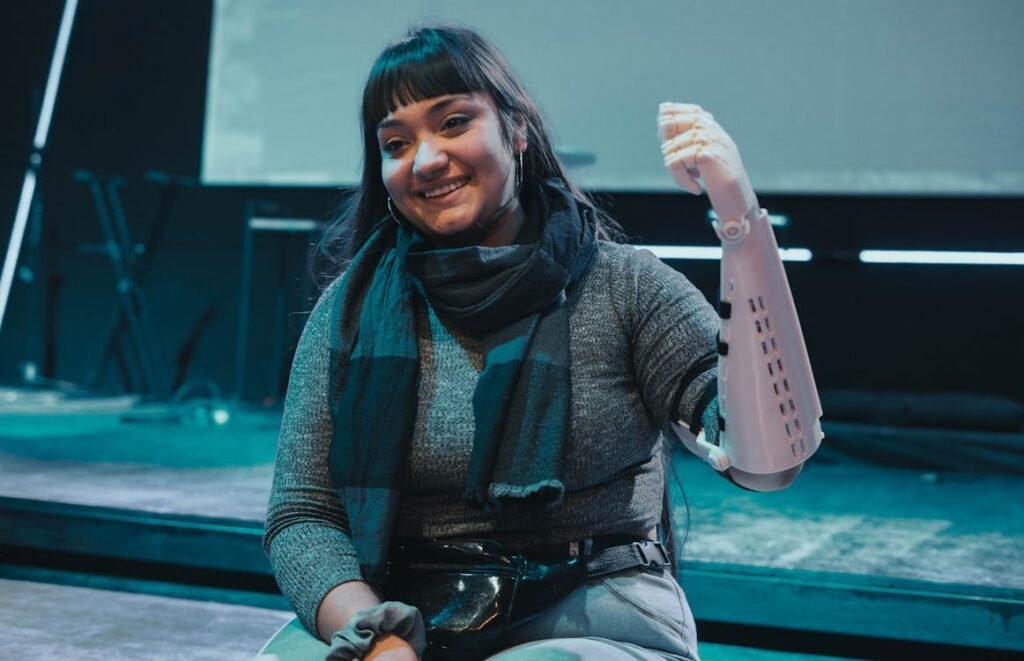When someone goes through a serious injury that leads to limb trauma, their life changes in ways most people can’t imagine. The first few days after the injury are filled with questions—about pain, movement, and what the future will look like. Once the wounds begin to heal, another big challenge comes up: how to get strong again.
Strength doesn’t return overnight. Muscles may have weakened during hospital stays or after surgery. Joints may feel stiff, balance might feel off, and doing basic tasks like standing or walking can feel harder than expected. That’s completely normal.
But here’s the good news: the body wants to recover. It wants to move. With the right exercises and a little patience, it’s possible to rebuild strength, regain control, and start feeling more confident every single day.
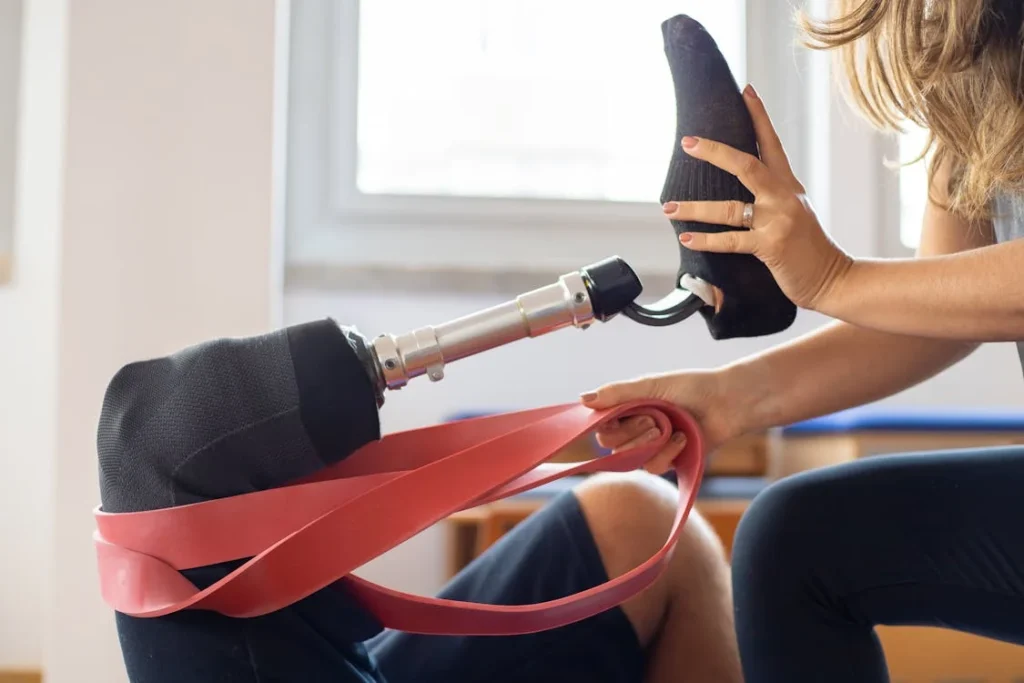
Preparing the Body for Movement After Limb Trauma
Before jumping into any kind of workout or rehabilitation program, the body needs time to adjust. After a trauma, everything feels different.
The way your muscles respond, the way you balance, even the way you breathe might feel off. That’s okay. Your body has been through a lot, and now it’s learning how to function with new patterns, sometimes even with a prosthetic.
This is the stage where recovery really begins—when the body starts to shift from surviving to rebuilding.
Understanding What the Body Needs
After limb trauma, your body is not just healing physically. It’s also recalibrating its sense of balance, coordination, and strength.
When part of a limb is damaged or lost, other muscles often take on extra work to help you move. Over time, this can cause uneven strength, stiffness, or pain in other areas like the back, shoulders, or hips.
So, the first step is learning how your body feels now. This isn’t about pushing hard. It’s about paying attention.
Are certain movements painful? Does one side of your body feel tighter or weaker than the other? Are you holding your breath during certain exercises? These small things matter.
You don’t need fancy equipment or high-intensity routines. In fact, the best results come from slow, mindful movement—done consistently over time.
The Importance of Breathing and Posture
It might sound basic, but breathing plays a huge role in strength recovery. After trauma, many people unknowingly hold their breath when doing physical tasks.
This can lead to tension, fatigue, and less control. Learning how to breathe deeply and calmly during movement is one of the easiest ways to help the body feel stronger and more stable.
Posture is just as important. If you’re using a prosthetic, you might find that you lean more to one side or put pressure unevenly on your legs or arms. This can create stress on your joints.
Before doing any strength-building exercises, it’s important to correct your posture and center your balance. A good physical therapist or rehab expert can help you learn what correct posture feels like—especially in sitting and standing positions.
Simple things like sitting tall, aligning your shoulders over your hips, or keeping your chin level with the floor can make a big difference in how exercises feel and how well your body responds.
Starting With the Core
When people think of strength, they often think of arms or legs. But in recovery, true strength starts at the core. This means the muscles around your stomach, back, and hips.
These muscles control your posture, your balance, and your ability to shift weight from one side to another.
After limb trauma, especially lower limb trauma, the core becomes even more important. It helps you stand up from a chair, move safely with a prosthetic, and avoid falls.
But after injury, these muscles can become weak, especially if you’ve been sitting or lying down for long periods.
Gentle core activation exercises are a great place to begin. Things like tightening your belly muscles while lying flat, or lifting your upper body slightly off the floor, can help build awareness and strength without putting too much pressure on the joints.
The goal is not six-pack abs. It’s control. It’s helping your body feel stable as you move through space again.
Engaging the Limb—With or Without a Prosthetic
Whether you’ve had surgery, are using a prosthetic, or are in the early stages of rehab, the next step is gently engaging the limb that’s been affected.
If you’ve lost part of your limb, the remaining muscles still need movement. If your limb is intact but healing, those muscles need gentle strengthening.
It’s common to feel unsure about using the affected side. There may be pain, swelling, or just fear of hurting yourself. But small, guided movements can do a lot of good.
They improve blood flow, reduce stiffness, and remind your brain that the limb is still part of your body.
Even something as simple as shifting weight onto your prosthetic side for a few seconds at a time can begin to rebuild strength and trust.
And remember—recovery is not about doing everything perfectly. It’s about building small wins, every day.
Listening to Pain, But Not Avoiding Effort
One of the hardest parts of recovery is knowing the difference between discomfort and danger. Some tightness or soreness is a normal part of healing. But sharp pain, swelling, or sudden weakness should always be taken seriously.
If something doesn’t feel right, it’s okay to stop. Rest is part of recovery, too. But don’t let the fear of discomfort stop you from trying.
Muscles that haven’t moved in a while will feel sore at first. That’s normal. What matters most is that you return to the exercises regularly.
Strength comes from consistency—not from doing everything all at once.
In the early stages, your best guide is your own body. And if you’re working with a therapist or using a rehab program, they’ll help you adjust your movements to stay safe while still making progress.
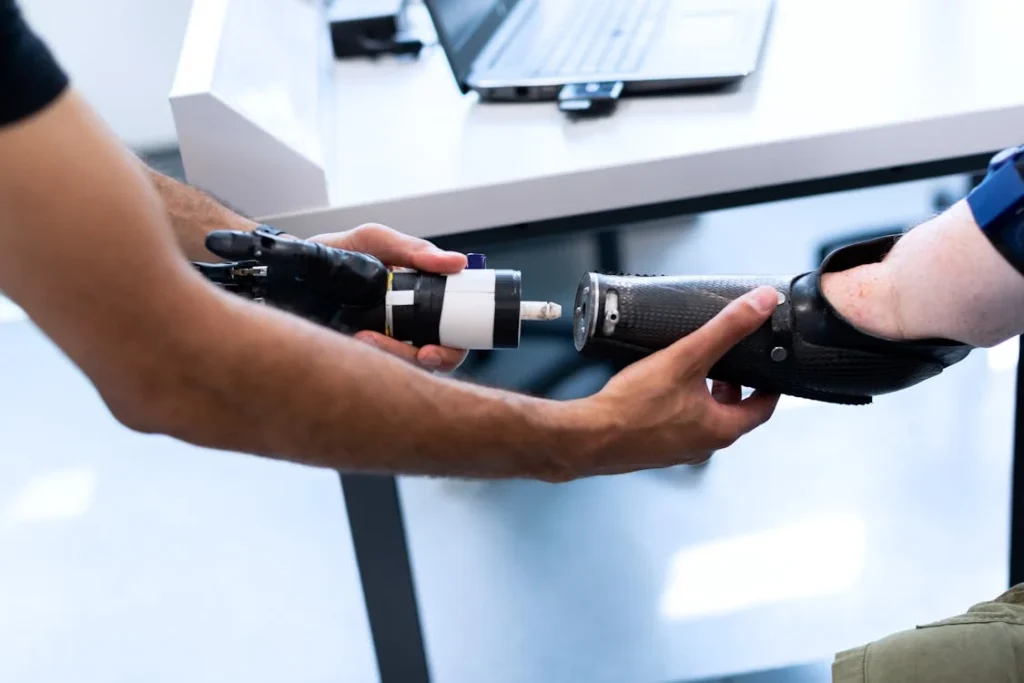
Rebuilding Strength Through Controlled Movement
Once your body is ready to move, the next step is to rebuild strength—slowly, safely, and with care. This part of recovery is where change becomes visible.
Muscles start to respond. Movements become smoother. Confidence builds. But this stage also requires patience. Strength doesn’t return overnight. It takes time, repetition, and the right mindset.
The focus should always be on form and control, not speed or intensity. When done right, even simple exercises can wake up forgotten muscles and start laying the path to independence.
Strengthening the Supporting Muscles
After limb trauma, some muscles get weaker simply because they’re not being used. Others work harder to support your movement.
Over time, this can create an imbalance. Maybe your hip is doing too much. Maybe your shoulders are overcompensating. These uneven patterns can lead to fatigue or even injury if they’re not corrected.
That’s why a key part of recovery is strengthening the supporting muscles—the muscles around your hips, thighs, shoulders, and back. They act like stabilizers. They don’t always move much, but they hold everything together.
For someone with a prosthetic leg, for example, the hip on that side becomes incredibly important. If it’s weak, walking becomes a struggle.
You might start to sway or feel unstable. But when it’s strong, it holds your body upright and helps transfer your weight naturally from one side to the other.
A good way to start strengthening is with bodyweight exercises. These are simple movements that use your own body—no machines, no weights—just you, your breath, and your control.
Things like seated leg lifts, gentle hip bridges, or slow side-stepping can help re-activate these core support muscles.
Even standing near a wall and gently lifting your leg to the side helps engage your hip. It’s not about how high you lift—it’s about doing it slowly and with purpose.
Building Balance With Every Step
Balance is often one of the first things to go after trauma. Whether the injury affects your arm or leg, your body loses its normal rhythm. That rhythm is something we usually take for granted—until it’s gone.
Regaining balance means teaching your brain and muscles to work together again. It starts with basic exercises like standing on one foot (with support), gently shifting your weight side to side, or using a balance board if you’re at a clinic.
For lower limb trauma, the feet and ankles—whether natural or prosthetic—play a big role in this. Even if you’re using a prosthetic, your body still needs to practice trusting that side again.
It might feel stiff or unsteady at first. That’s okay. With time and repetition, the trust returns.
Each small step forward—literally—tells your nervous system: “We’re doing this. We’re okay.”
Balance work is not just about avoiding falls. It also helps with walking smoothly, climbing stairs, and even sitting down or standing up without using your arms for support.
Muscle Memory and Repetition
One of the best tools you have in your recovery is muscle memory. This is the body’s way of remembering how to move. The more you repeat a movement, the more natural it becomes. Even after trauma, this memory can be rebuilt.
At first, it might feel like your body has forgotten how to move. That’s normal. Movements may feel clunky or unsure. But the more you practice, the more those movements become automatic again.
You don’t need long workouts. In fact, shorter, more frequent sessions often work better. Doing a few minutes of movement several times a day can build strength faster than one long, tiring session.
It’s about feeding the body the right signals—again and again.
And because the body is still healing, it’s important to focus on quality over quantity. One slow, well-balanced step is worth more than five rushed ones.
Making Movement a Habit
What turns recovery into long-term progress is habit. The more movement becomes a part of your day, the easier it is to maintain strength. This doesn’t mean turning your home into a gym. It means building small actions into your daily life.
Maybe you stand up and sit down from your chair five times before meals. Maybe you walk a few extra steps each morning. Maybe you stretch before bed.
These small actions add up—and more importantly, they keep your body active without exhausting it.
For prosthetic users, walking regularly—even inside the house—can help keep muscles engaged and maintain socket comfort. The more the limb is used, the better the fit often becomes. And your confidence will grow along with your strength.
It’s also okay to adjust based on how you’re feeling. Some days you’ll have more energy. Other days, less. The key is to do something—even a little—and to stay consistent over time.
Strength as a Feeling, Not Just a Goal
It’s easy to get caught up in the idea of being “fully recovered” or “strong again.” But strength is not just about lifting heavy things or walking long distances. Strength is also a feeling.
It’s the moment you stand up without help. The time you walk across the room with steady steps. The day you realize your body feels more connected than it did last week. These are the moments where recovery lives.
And this kind of strength is not measured in numbers. It’s felt in confidence, ease, and the quiet return of everyday life.
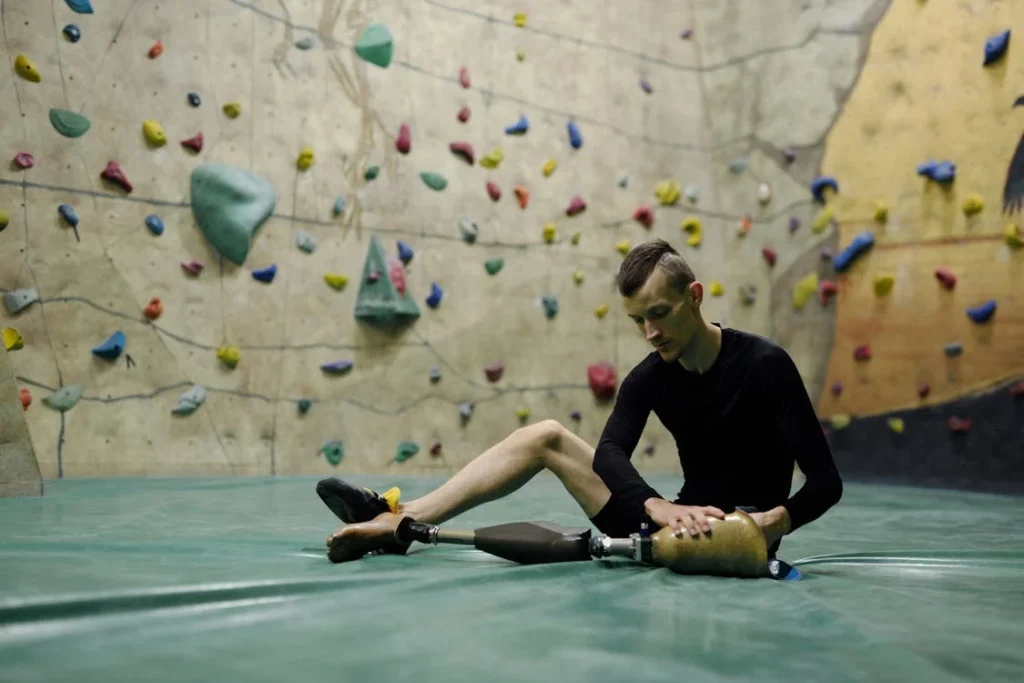
Strengthening the Mind Through Movement
After limb trauma, the physical injury is only part of the recovery. The emotional journey is just as real—and often even harder to talk about.
Fear, frustration, sadness, and uncertainty can creep in quietly and sit heavy on a person’s spirit. That’s why strength after trauma must include both the body and the mind.
And movement—yes, even slow, shaky, unsure movement—is one of the best tools we have to build emotional strength.
Moving Through Fear
One of the most common emotions after trauma is fear. Fear of falling. Fear of failing. Fear of pain. It’s the kind of fear that makes people freeze. They avoid walking too far, or standing up without support. They second-guess every move.
But here’s what many people don’t realize: movement itself helps ease that fear. The first time you shift your weight onto your healing leg and don’t fall, something changes.
The moment you take two steps across the room without reaching for a wall, your mind begins to trust your body again.
These moments don’t erase fear completely, but they chip away at it. Slowly, steadily, you begin to feel capable again. That’s how confidence grows—not through giant leaps, but through small, repeated victories.
A structured rehab routine—guided by a therapist or tailored to your needs—can help make movement feel safer. Over time, as your body gets stronger, your fear often begins to soften.
Restoring Trust in the Body
After trauma, many people feel disconnected from their bodies. The injury, the surgery, the prosthetic—it all creates a sense of unfamiliarity. Your body doesn’t feel like “yours” anymore.
This disconnection can be deeply emotional. You may feel distant from your own strength. You may wonder if you’ll ever feel whole again.
Exercise helps repair this gap. Not because it makes your body perfect—but because it makes your body present.
When you move, stretch, breathe, or lift, you reconnect with muscles, joints, and senses that were quiet for too long. You begin to feel like yourself again.
Even gentle movement can have this effect. A seated exercise that wakes up your back muscles. A standing stretch that reminds your hips how to carry weight. These actions tell your brain: I am still here. I still belong in this body. I can still trust it.
Over time, that trust builds into a sense of ownership. And that ownership is powerful. It helps you feel less like a patient—and more like a person again.
Using Exercise to Manage Stress and Mood
Physical recovery can be slow. And slow progress can be frustrating. It’s normal to feel impatient, especially when you’re doing everything right but results come in inches instead of miles.
That’s where movement helps in ways you can’t always see. Exercise releases natural chemicals in the brain—endorphins and serotonin—that boost mood and reduce stress.
These are the same chemicals that help fight anxiety and depression. You don’t need to run a marathon to feel the effect. Even 10 minutes of focused movement can help.
Some people notice that on the days they move more, they sleep better. Others say they feel less irritated or restless after a short rehab session. These are subtle signs that the body and mind are working together again.
When movement becomes a regular part of the day, it gives your mind something to focus on. A task. A goal. A rhythm. It brings back a sense of purpose, which is often missing after trauma.
Building Mental Endurance Alongside Physical Strength
Just like your muscles need repetition to get stronger, your mindset does too. And there’s something about physical movement that builds mental endurance. It teaches you how to keep going, even when it’s hard.
That’s why rehab exercises—however small—matter so much. They’re not just about strengthening the limb. They’re about learning how to face discomfort, work through fear, and come back again the next day.
Some days will feel easy. Others will feel like you’re dragging yourself through the motions. But every day you show up, you’re practicing resilience. And that resilience slowly becomes part of who you are.
The people who recover the strongest are not always the fastest or fittest. They’re the ones who stay consistent. Who keep showing up. Who allow themselves to rest when needed, but never let setbacks define their story.
A Safe Space for Emotions
Exercise and rehab also give you a space to process emotion—without needing to say anything out loud. Some people find peace in the routine.
Others release anger through focused movement. For many, it’s a quiet time where the body and mind speak to each other.
This emotional release is part of healing. It helps prevent emotional buildup that can lead to burnout, withdrawal, or depression. It reminds you that recovery is not about being cheerful all the time. It’s about being real—and still moving forward.
You don’t need to push yourself to feel something specific. Just show up. Let the movement guide your body, and let your emotions come and go as they need to. That’s enough.
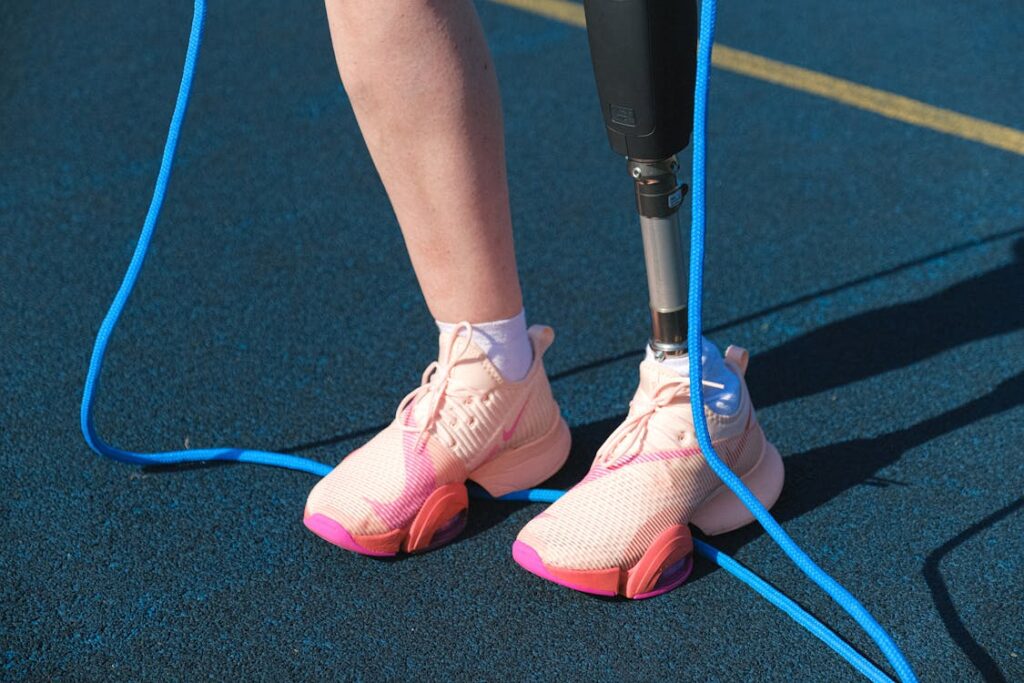
Progress Over Time: Evolving Exercise as You Heal
Healing after limb trauma doesn’t follow a straight line. Some days bring noticeable gains, while others feel like a step backward. That’s not failure—it’s normal.
The body is doing hard work, and progress comes in waves. What matters most is how you respond to each phase of recovery, and how your exercise routine adapts along with it.
As your body heals, the way you move will change. The exercises that once felt challenging will start to feel easier. That’s a good sign—it means your strength is returning.
But it also means it’s time to evolve your routine so your body keeps growing stronger.
From Basics to Functional Strength
At the beginning, exercises are usually about reintroducing movement and stability. Things like core activation, seated leg raises, or standing weight shifts form the base of your strength.
But as those exercises become more familiar, it’s important to take the next step: building functional strength.
Functional strength refers to the kind of strength you use every day—to get out of a chair, carry groceries, or walk up a slope. It’s not about lifting heavy weights. It’s about moving in a way that supports real life.
Exercises during this stage might include sit-to-stand practice, controlled stair climbing, or walking for longer periods of time. These movements help connect your growing muscle strength with the actual motions you’ll use every day.
If you’re using a prosthetic, this is where your alignment, balance, and walking pattern become even more important.
Working with a therapist or trained specialist can help fine-tune your movements to avoid strain or poor habits. Remember, quality of movement is more important than quantity.
Adapting to New Challenges
One of the hardest things about long-term recovery is knowing when to push and when to pause. As you gain strength, you’ll feel more capable—and that’s great.
But you may also hit new walls. Maybe your stamina isn’t what it used to be. Maybe your muscles tire out faster. Maybe you notice soreness in a new area. This is all part of the process.
Each time your exercise routine evolves, your body has to adjust again. And just like in the early stages, the key is consistency.
Don’t be afraid to slow down and focus on form. If a new movement feels difficult, that doesn’t mean you’re doing it wrong. It means your body is learning something new.
It’s helpful to think of progress like climbing a hill. Sometimes the slope is gentle. Sometimes it gets steep. And sometimes you have to pause and catch your breath before moving forward again. That pause is not failure—it’s recovery.
Staying Motivated Over the Long Term
Exercise is easier to commit to when progress is visible. But what happens when the improvements become more subtle?
This is a common point where motivation can drop. In the beginning, you might notice clear results—better balance, less pain, more confidence. But as your body gets stronger, the changes get smaller. They still matter, but they’re harder to notice.
That’s why it helps to shift your focus from short-term results to long-term goals. Maybe you want to walk around the block without stopping.
Maybe you want to dance at a family event. Maybe you just want to feel steady enough to carry a bag of groceries. These goals give your exercise a purpose.
It also helps to celebrate the small wins. Maybe you stood a little taller today. Maybe your steps felt more natural. Maybe you did your routine even when you didn’t feel like it. Those moments are worth noticing. They are signs of quiet strength.
And if your motivation fades now and then, don’t beat yourself up. Rest is part of the process too. What matters is that you return. Again and again.
Listening to the Body’s Signals
As your body adapts and strengthens, it becomes your best guide. You’ll start to notice when something feels “off”—tightness in the socket, uneven pressure, or muscles that feel overworked.
Pay attention to these signals. They’re not just discomfort. They’re messages.
Sometimes the answer is simple: stretch more, rest more, hydrate better. Other times, your prosthetic might need adjusting, or your routine needs a refresh. Either way, listening to your body helps you avoid injury and move forward safely.
It also helps you recognize real fatigue versus mental resistance. On some days, you might be tired because your muscles truly need recovery.
On others, you might just feel stuck or unmotivated. Knowing the difference comes with time—and with patience.
The Role of Support in Continued Progress
You don’t have to do this alone. As your routine changes, your support system should grow with it.
This might include regular check-ins with a physiotherapist, occasional sessions with a prosthetist, or even talking to others who’ve gone through similar journeys.
Peer support can be surprisingly powerful. Sometimes just hearing, “I struggled with that too,” is enough to keep going.
Whether it’s online or in person, being part of a recovery community can remind you that you’re not alone—and that your efforts matter.
Even family and friends can play a big role. Maybe they help you track your progress, or join you in a walk. Their encouragement, even in small ways, can keep your mindset strong when your energy is low.
Long-term recovery takes time, but every stage has value. As you evolve, so does your strength—physically, mentally, and emotionally.
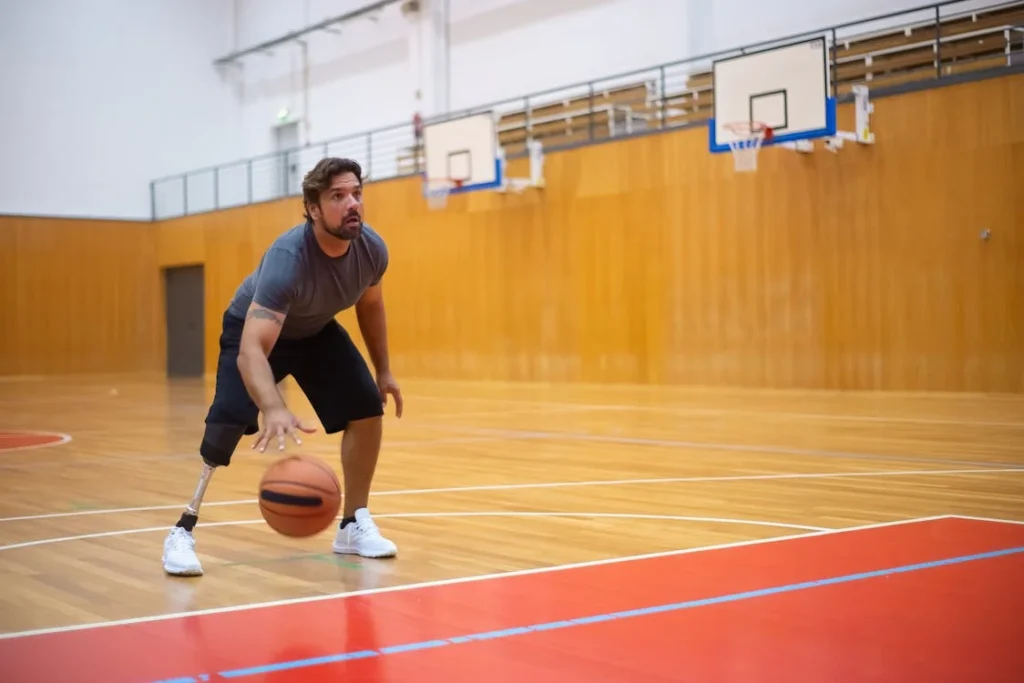
Exercising in Real Life: Adapting to Different Environments
Once you’ve begun to regain some strength and rhythm, the next part of your recovery journey begins to shift beyond clinic walls and therapy rooms. Real life brings new surfaces, distractions, and daily routines that require your body to adapt again.
Each environment—whether it’s your home, a rehab center, or the outside world—comes with its own set of challenges and opportunities for movement.
Knowing how to adjust your exercises for each setting can help you maintain progress without losing comfort, safety, or confidence.
Movement at Home: Making Everyday Tasks Part of Recovery
For most people, home is the first and longest setting for rehabilitation. And while it might feel limiting at times, your own space can become one of the best places to rebuild strength—especially when you’re learning how to move again after trauma.
The key is to use daily activities as opportunities for exercise. Standing up from a chair becomes a strength drill. Walking to the kitchen becomes gait practice. Reaching for items in the cupboard helps with balance and range of motion.
Of course, the home environment isn’t always perfect. Floors may be slippery, furniture can get in the way, or space might be too tight to move freely. But small adjustments make a big difference.
Placing non-slip mats in key areas, using a sturdy chair for support during leg lifts, or setting up a simple routine in an open area can create a safe, supportive rehab zone right at home.
One of the biggest advantages of exercising at home is consistency. You don’t have to wait for an appointment or travel to a clinic.
You can move when you feel ready, for as long or as little as your energy allows. It also gives you more privacy, which can reduce anxiety—especially during the early stages of recovery.
Structured Rehab Spaces: Pushing Progress with Expert Support
While home is great for comfort and convenience, rehab centers provide something equally important: structure. These spaces are designed to challenge you—safely.
With trained professionals, specialized equipment, and a controlled environment, rehab centers allow you to try new exercises, correct bad habits, and get real-time feedback.
If you’re working on walking with a prosthetic leg, for example, the center might have parallel bars, uneven surface mats, or incline ramps that help your body learn how to handle different scenarios.
Therapists can also introduce you to tools like resistance bands, balance boards, and step platforms to activate underused muscles.
Rehab centers also allow for regular tracking of your progress. This might include gait analysis, strength testing, or flexibility checks.
Seeing your numbers improve—even slightly—can be incredibly motivating. It’s proof that the work you’re doing matters.
What’s important to remember is that you don’t have to be in a rehab center forever. Think of it as a foundation builder. It’s a place to learn, experiment, and practice.
Once you feel confident, many of the movements can be replicated at home or outdoors using simpler setups.
Public Spaces: Building Confidence Through Real-World Movement
At some point in recovery, you’ll find yourself outside again—navigating parks, sidewalks, public buildings, or even going back to work. This is a huge milestone. It’s also a big adjustment.
Outside environments are unpredictable. You might face uneven ground, sudden changes in slope, or lots of people moving around you.
These factors can trigger anxiety, especially if your balance isn’t fully restored. But these moments also offer real-world feedback.
Walking on grass or gravel challenges your ankle and hip stability. Climbing stairs tests your coordination and strength.
Navigating crowded places improves your awareness and reaction time. All of this is exercise, even if it doesn’t feel like a workout.
When you’re ready, try taking short, planned outings. Maybe a walk through the park with a family member. A quiet time at the grocery store.
A short ride on public transport. Each experience helps rebuild not only your physical strength but your independence too.
It’s okay if it doesn’t feel perfect at first. You might walk slower or take more breaks. That’s part of learning. The more your body moves through real life, the more it adapts. And that adaptation is where strength becomes sustainable.
Travel, Climate, and Your Recovery Routine
Not all environments are created equal. Climate, terrain, and even altitude can affect how your body feels and responds to movement.
For example, heat can cause sweating that makes your prosthetic feel slippery or uncomfortable. Cold can make joints stiffer or reduce sensation in your limb.
If you live in a rainy area, wet sidewalks and slippery entryways become part of your daily risk assessment. If you’re in a rural area, dirt paths and uneven roads may require more balance and muscle control.
These are more than environmental details—they directly affect your comfort and confidence.
That’s why it’s useful to plan ahead. If your routine involves morning walks, choose routes with good lighting and even surfaces.
If weather conditions shift suddenly, have a backup plan for indoor movement. The goal is not to avoid challenges but to adapt thoughtfully so you can keep exercising safely no matter the setting.
Your routine should grow to include exercises that match your environment. If your workplace has stairs, practice stair stepping in rehab.
If your community has sloped walkways, work on incline walking with your therapist. Preparing for the world you live in turns daily activity into skill-building.
Being Mindful of Energy and Environment
Different places affect not only your physical body but also your mental energy. Some people feel more motivated to move at home. Others find that being in a rehab center brings focus. And for some, being outdoors sparks the most joy.
Try to notice where you feel strongest—or most limited. This self-awareness can guide how you plan your exercises.
If a certain space makes you anxious, start with smaller goals there. If a particular routine feels calming, keep it as part of your daily rhythm.
No matter where you move, the most important thing is that you keep moving.
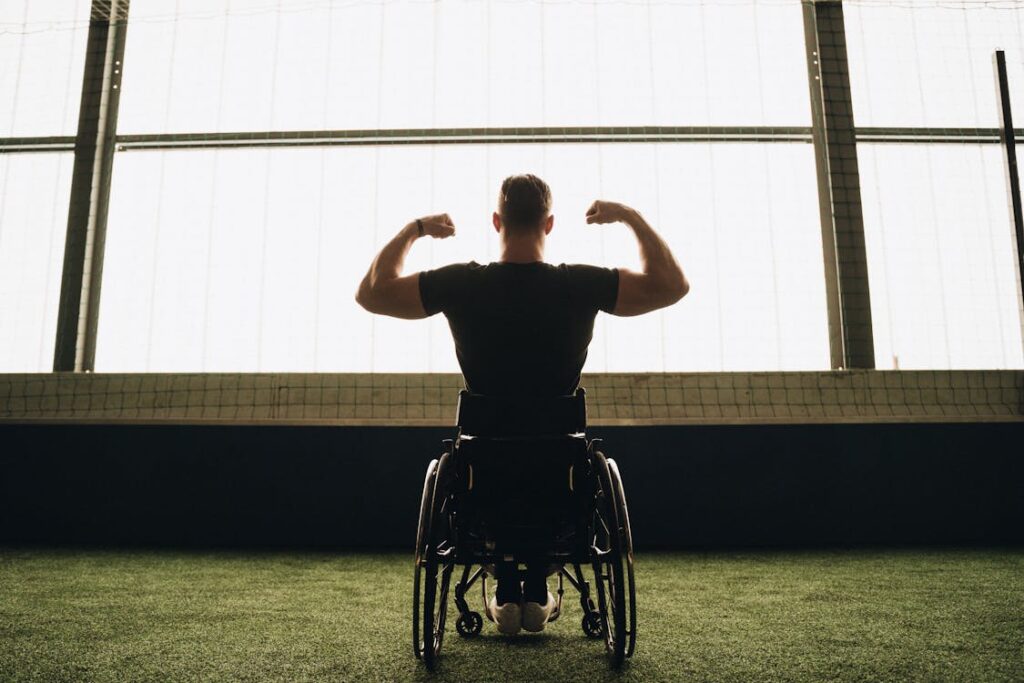
Tools and Devices That Support Strength Recovery
Recovering strength after limb trauma doesn’t always mean working harder. Sometimes, it’s about working smarter. That’s where simple tools and assistive devices come in.
These aren’t just gadgets or add-ons—they’re practical, thoughtful pieces of support that allow you to move more safely and with better results.
Used properly, they can help you build strength faster, reduce injury risk, and feel more in control of your recovery process.
Using Support Tools for Safety and Confidence
When you first begin moving after a trauma, your body might feel unfamiliar. Balance could be shaky. Muscles may fatigue quickly. This is where external support can help—not as a crutch, but as a guide.
Handrails, sturdy chairs, countertops, and walkers can all provide points of contact that reduce your risk of falling. More importantly, they give you the confidence to try.
Knowing you have something to hold onto can make all the difference when standing up, shifting your weight, or taking a step.
These supports also allow you to focus on form, which is essential in early rehab. Instead of rushing through an exercise and risking poor posture, you can move slowly and correctly—building muscle memory in the right way.
As you progress, you may need these tools less and less. But they’re still valuable when introducing new exercises or returning after a setback.
Think of them as part of your rehab toolbox—there when you need them, easy to step back from when you don’t.
Resistance Bands: Small but Powerful
One of the simplest and most effective tools for strength recovery is the resistance band. These stretchy, lightweight bands provide controlled tension that activates your muscles without putting stress on your joints.
If lifting weights feels too hard or unsafe, resistance bands offer a gentler way to build strength. You can use them while sitting, lying down, or standing—making them perfect for people at all stages of recovery.
Whether you’re working on hip strength, shoulder mobility, or ankle control, there’s likely a band exercise that fits your needs.
Bands are also easy to store and carry, which means you can keep your routine consistent whether you’re at home, at therapy, or traveling. They grow with you, too—starting with light resistance and moving up as you get stronger.
More than just convenience, resistance bands allow for controlled, repeatable movement. That makes it easier to track your progress and notice which muscles are responding, and where you might still need work.
Therapy Balls and Cushions for Core and Balance
Another helpful category of tools includes therapy balls, foam rollers, and balance cushions. These props help improve core strength, stability, and posture—all of which play a big role in walking, standing, and staying safe after limb trauma.
Sitting on a therapy ball while doing arm movements, for example, engages your abdominal muscles in a subtle but powerful way.
Using a balance cushion while standing or performing weight shifts challenges your ankle and hip stabilizers—muscles that often weaken during recovery.
Foam rollers are especially useful for releasing muscle tension. After trauma or surgery, muscles around the affected area can tighten up as a way to protect the body.
But over time, that tightness can limit movement and create pain. Gentle foam rolling can help improve blood flow and reduce stiffness, making it easier to stretch and move without discomfort.
Using these tools may feel unfamiliar at first, but with guidance from a therapist or detailed instruction, they become part of a routine that not only strengthens but restores control over how your body moves and feels.
Adjustable Ankle Weights for Strength and Endurance
Once basic movements become easier, adding ankle or wrist weights can increase challenge and support continued strength building.
These adjustable weights don’t need to be heavy—sometimes just 500 grams to one kilogram is enough to activate deeper muscle fibers.
The key is not to overdo it. Start with the lightest option and use it during exercises you already know. For example, wearing ankle weights during seated leg lifts or while standing and lifting your prosthetic side can provide a new level of resistance.
These weights help build endurance, too. As your body gets used to the extra load, movements like walking, standing for long periods, or climbing stairs become easier when the weights are removed.
Again, guidance is important. Adding weight too early or using poor form can lead to injury. But introduced at the right time, this simple tool becomes an excellent way to keep progressing.
Mirrors, Apps, and Feedback Tools for Alignment
Sometimes, the most important tools don’t strengthen your body—they teach you how to move better.
After limb trauma, it’s common to develop small habits that throw off alignment. You might lean too far to one side, lift your shoulders unevenly, or rotate your torso when walking. These are understandable—but over time, they can cause strain or pain.
Using a mirror while you exercise can help. It gives you real-time visual feedback so you can correct your posture or notice when your movement pattern is off. It’s a surprisingly effective way to take control of your form without needing high-tech gear.
If you enjoy using technology, there are apps that can track steps, monitor your posture, or guide you through rehab routines.
Some apps are even designed for prosthetic users and can help you set reminders, log how long you wear your prosthesis, or record your walking patterns.
These tools are especially helpful if you’re working alone or between therapy sessions. They keep you accountable, offer structure, and give you a way to reflect on your progress over time.
Making Tools Work for You
The most important thing to remember about these tools is that they’re there to support your recovery—not define it. You don’t need to use every gadget or buy expensive gear.
Start with what you have. Use tools that match your current stage. Focus on comfort, safety, and repeatable movements.
If something feels helpful, keep it. If it feels confusing or uncomfortable, talk to your therapist or support team before continuing.
Over time, these props can be phased out or swapped for more advanced tools. They’re meant to help you progress, not hold you back.
What matters most is that you keep moving—and that you feel supported every step of the way.
Conclusion
Regaining strength after limb trauma is not about rushing or reaching perfection. It’s about rebuilding trust in your body, one step at a time. From simple movements at home to structured exercises in rehab, every action matters. Strength is more than muscle—it’s balance, confidence, and the ability to face each day with more control than the last.
With the right mindset, tools, and support, recovery becomes a journey of progress, not pressure. Some days will feel strong, others less so—but every small effort brings you closer to freedom and independence.
Whether you’re just starting out or already walking confidently with a prosthetic, keep moving forward. The path may be slow, but it leads to real, lasting strength.



